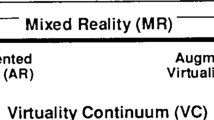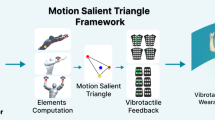Abstract
Understanding stress distributions over 3D models is a highly desired feature in many scientific and engineering fields. The stress is mathematically a second-order tensor, and it is typically visualized using either color maps, tensor glyphs, or streamlines. However, neither of these methods is physically intuitive to the end user, and they become even more awkward when dealing with the volumetric tensor field over a complicated 3D shape. In this paper, we present a virtual perception system, which leverages a multi-finger haptic interface to help users intuitively perceive 3D stress fields. Our system allows the user to navigate the interior of the 3D model freely and maps the stress tensor to the haptic rendering along the direction of the finger’s trajectory. Doing so provides user a natural and straightforward understanding of the stress distribution without interacting with the parameters in the mapped visual representations. Experimental results show that our system is preferred in navigating stress fields inside an object and is applicable for different design tasks.











Similar content being viewed by others
References
Achibet, M., Girard, A., Talvas, A., Marchal, M., LšŠcuyer, A.: Elastic-arm: Human-scale passive haptic feedback for augmenting interaction and perception in virtual environments. In: 2015 IEEE Virtual Reality (VR), pp. 63–68 (2015)
Avila, R.S., Sobierajski, L.M.: A haptic interaction method for volume visualization. In: Proceedings of Visualization ’96, pp. 197–204 (1996)
Bhalerao, A., Westin, C.F.: Tensor splats: Visualising tensor fields by texture mapped volume rendering. In: Medical Image Computing and Computer-Assisted Intervention—MICCAI 2003, pp. 294–302. Springer, Berlin (2003)
Chen, D., Song, A., Tian, L., Fu, L., Zeng, H.: FW-Touch: a finger wearable haptic interface with an MR foam actuator for displaying surface material properties on a touch screen. IEEE Trans. Haptics 12(3), 281–294 (2019)
Delmarcelle, T., Hesselink, L.: Visualizing second-order tensor fields with hyperstreamlines. IEEE Comput. Graph. Appl. 13(4), 25–33 (1993)
Dick, C., Georgii, J., Burgkart, R., Westermann, R.: Stress tensor field visualization for implant planning in orthopedics. IEEE Trans. Visual Comput. Graph. 15(6), 1399–1406 (2009)
Faeth, A., Oren, M., Sheller, J., Godinez, S., Harding, C.: Cutting, deforming and painting of 3d meshes in a two handed viso-haptic vr system. In: 2008 IEEE Virtual Reality Conference, pp. 213–216 (2008)
Fung, Y.C.: Foundations of Solid Mechanics. Prentice-Hall, Upper Saddle River (1965)
Gerrits, T., Rössl, C., Theisel, H.: Glyphs for general second-order 2d and 3d tensors. IEEE Trans. Vis. Comput. Graph. 23(1), 980–989 (2017)
Gescheider, G.A.: Psychophysics: The Fundamentals. Psychology Press, London (2013)
Gleeson, B.T., Horschel, S.K., Provancher, W.R.: Communication of direction through lateral skin stretch at the fingertip. In: World Haptics 2009—Third Joint EuroHaptics conference and Symposium on Haptic Interfaces for Virtual Environment and Teleoperator Systems, pp. 172–177 (2009)
Hinchet, R., Vechev, V., Shea, H., Hilliges, O.: Dextres: wearable haptic feedback for grasping in vr via a thin form-factor electrostatic brake. In: Proceedings of the 31st Annual ACM Symposium on User Interface Software and Technology, UIST ’18, pp. 901–912 (2018)
Hirota, K., Tagawa, K.: Interaction with virtual object using deformable hand. In: 2016 IEEE Virtual Reality (VR), pp. 49–56 (2016)
Hlawitschka, M., Hotz, I., Kratz, A., Marai, G.E., Moreno, R., Scheuermann, G., Stommel, M., Wiebel, A., Zhang, E.: Top challenges in the visualization of engineering tensor fields. In: Visualization and Processing of Tensors and Higher Order Descriptors for Multi-Valued Data, pp. 3–15 (2014)
Jacobs, J., Froehlich, B.: A soft hand model for physically-based manipulation of virtual objects. In: 2011 IEEE Virtual Reality Conference, pp. 11–18 (2011)
Kim, M., Cho, S., Tran, T.Q., Kim, S.P., Kwon, O., Han, J.: Scaled jump in gravity-reduced virtual environments. IEEE Trans. Vis. Comput. Graph. 23(4), 1360–1368 (2017)
Kindlmann, G., Weinstein, D., Hart, D.: Strategies for direct volume rendering of diffusion tensor fields. IEEE Trans. Vis. Comput. Graph. 6(2), 124–138 (2000)
Kratz, A., Schoeneich, M., Zobel, V., Burgeth, B., Scheuermann, G., Hotz, I., Stommel, M.: Tensor visualization driven mechanical component design. In: 2014 IEEE Pacific Visualization Symposium, pp. 145–152 (2014)
Laha, B., Sensharma, K., Schiffbauer, J.D., Bowman, D.A.: Effects of immersion on visual analysis of volume data. IEEE Trans. Vis. Comput. Graph. 18(4), 597–606 (2012)
Levitt, H.: Transformed up-down methods in psychoacoustics. J. Acoust. Soc. Am. 49(2B), 467–477 (1971)
Li, M., Luo, S., Nanayakkara, T., Seneviratne, L.D., Dasgupta, P., Althoefer, K.: Multi-fingered haptic palpation using pneumatic feedback actuators. Sens. Actuators A Phys. 218, 132–141 (2014)
Maciel, A., Sarni, S., Buchwalder, O., Boulic, R., Thalmann, D.: Multi-finger haptic rendering of deformable objects. In: Eurographics Workshop on Virtual Environments (2004)
Pacchierotti, C., Salvietti, G., Hussain, I., Meli, L., Prattichizzo, D.: The hring: a wearable haptic device to avoid occlusions in hand tracking. In: 2016 IEEE Haptics Symposium (HAPTICS), pp. 134–139 (2016)
Palke, D., Lin, Z., Chen, G., Yeh, H., Vincent, P., Laramee, R., Zhang, E.: Asymmetric tensor field visualization for surfaces. IEEE Trans. Vis. Comput. Graph. 17(12), 1979–1988 (2011)
Sagardia, M., Hulin, T.: Evaluation of a penalty and a constraint-based haptic rendering algorithm with different haptic interfaces and stiffness values. In: 2017 IEEE Virtual Reality (VR), pp. 64–73 (2017)
Sagardia, M., Weber, B., Hulin, T., Hirzinger, G., Preusche, C.: Evaluation of visual and force feedback in virtual assembly verifications. In: 2012 IEEE Virtual Reality Workshops (VRW), pp. 23–26 (2012)
Salada, M., Colgate, J.E., Vishton, P., Frankel, E.: Two experiments on the perception of slip at the fingertip. In: Proceedings of the 12th International Symposium on Haptic Interfaces for Virtual Environment and Teleoperator Systems (HAPTICS’04) (2004)
Salisbury, K., Conti, F., Barbagli, F.: Haptic rendering: introductory concepts. IEEE Comput. Graph. Appl. 24(2), 24–32 (2004)
Schroeder, W., Martin, K., Lorensen, B.: The Visualization Toolkit: An Object-Oriented Approach To 3D. Graphics. Kitware, New York (2006)
Serina, E.R., Mockensturm, E., Mote, C., Rempel, D.: A structural model of the forced compression of the fingertip pulp. J. Biomech. 31(7), 639–646 (1998)
Sifakis, E., Barbic, J.: Fem simulation of 3d deformable solids: a practitioner’s guide to theory, discretization and model reduction. In: ACM SIGGRAPH 2012 Courses, pp. 20:1–20:50 (2012)
Weichert, F., Bachmann, D., Rudak, B., Fisseler, D.: Analysis of the accuracy and robustness of the leap motion controller. Sensors 13(5), 6380–6393 (2013)
Xia, P.: Haptics for product design and manufacturing simulation. IEEE Trans. Haptics 9(3), 358–375 (2016)
Yang, Z., Kollmannsberger, S., Düster, A., Ruess, M., Garcia, E.G., Burgkart, R., Rank, E.: Non-standard bone simulation: interactive numerical analysis by computational steering. Comput. Vis. Sci. 14(5), 207–216 (2011)
Zehner, B.: Interactive exploration of tensor fields in geosciences using volume rendering. Comput. Geosci. 32(1), 73–84 (2006)
Zhang, E., Hays, J., Turk, G.: Interactive tensor field design and visualization on surfaces. IEEE Trans. Vis. Comput. Graph. 13(1), 94–107 (2007)
Acknowledgements
The authors would like to thank anonymous reviewers for their constructive comments. This work has been supported by the National Key Technologies R&D Program under Grants No. 2019YFC-0119303, the NSFC under Grants No. 61773219, 61673114, and the Zhishan Youth Scholar Program of SEU.
Author information
Authors and Affiliations
Corresponding author
Ethics declarations
Conflict of interest
The authors declare that they have no conflict of interest.
Additional information
Publisher's Note
Springer Nature remains neutral with regard to jurisdictional claims in published maps and institutional affiliations.
Electronic supplementary material
Below is the link to the electronic supplementary material.
Supplementary material 1 (mp4 48175 KB)
Rights and permissions
About this article
Cite this article
Zhu, L., Ren, R., Chen, D. et al. Feel the inside: A haptic interface for navigating stress distribution inside objects. Vis Comput 36, 2445–2456 (2020). https://doi.org/10.1007/s00371-020-01891-9
Published:
Issue Date:
DOI: https://doi.org/10.1007/s00371-020-01891-9




